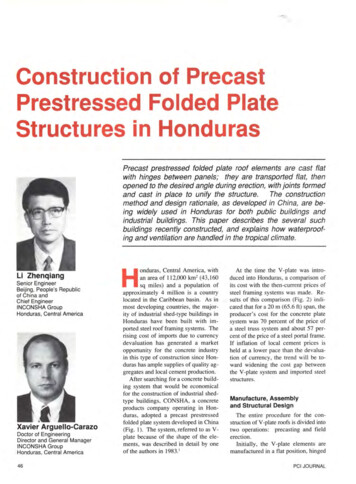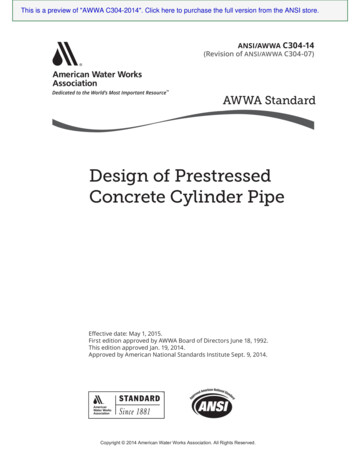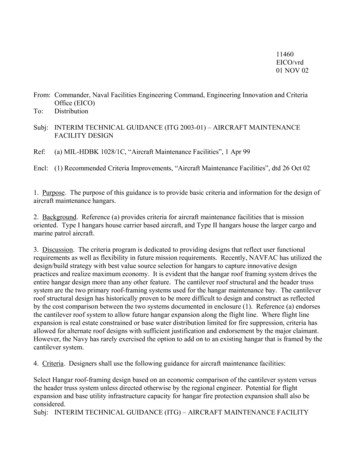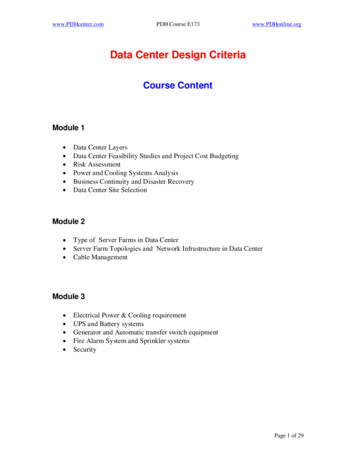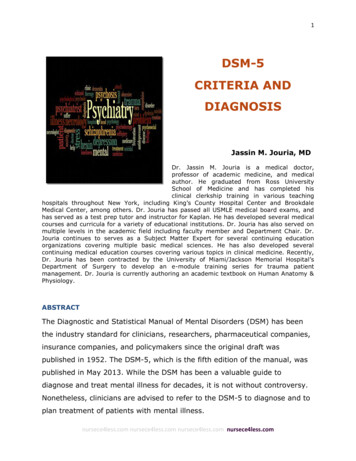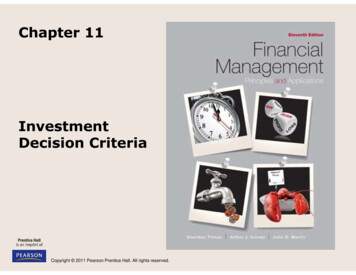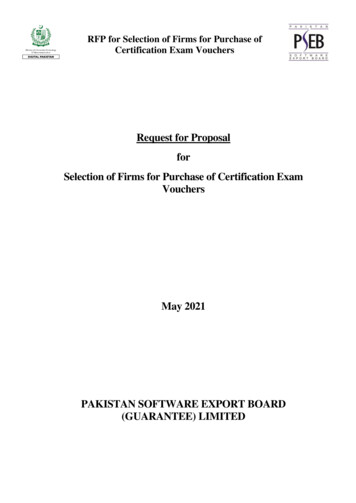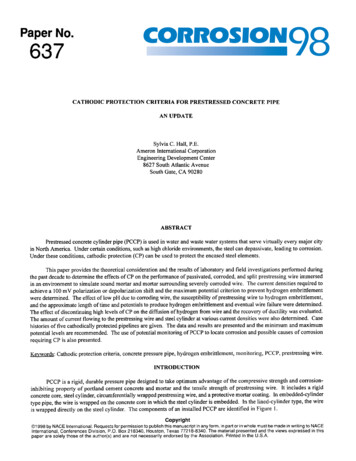
Transcription
Paper No.637CATHODICPROTECTIONCRITERIAFOR PRESTRESSEDCONCRETEPIPEAN UPDATESylvia C. Hall, P.E.Ameron International CorporationEngineering Development Center8627 South Atlantic AvenueSouth Gate, CA 90280ABSTRACTPrestressed concrete cylinder pipe (PCCP) is used in water and waste water systems that serve virtually every major cityin North America. Under certain conditions, such as high chloride environments, the steel can depassivate, leading to corrosion.Under these conditions, cathodic protection (CP) can be used to protect the encased steel elements.This paper provides the theoretical consideration and the results of laboratory and field investigations performed duringthe past decade to determine the effects of CP on the performance of passivated, corroded, and split prestressing wire immersedin an environment to simulate sound mortar and mortar surrounding severely corroded wire. The current densities required toachieve a 100 mV polarization or depolarization shift and the maximum potential criterion to prevent hydrogen embrittlementwere determined. The effect of low pH due to corroding wire, the susceptibility of prestressing wire to hydrogen embrittlement,and the approximate length of time and potentials to produce hydrogen embrittlement and eventual wire failure were determined.The effect of discontinuing high levels of CP on the diffusion of hydrogen from wire and the recovery of ductility was evaluated.The amount of current flowing to the prestressing wire and steel cylinder at various current densities were also determined. Casehistories of five cathodically protected pipelines are given. The data and results are presented and the minimum and maximumpotential levels are recommended.The use of potential monitoring of PCCP to locate corrosion and possible causes of corrosionrequiring CP is also presented.Keywords: Cathodic protection criteria, concrete pressure pipe, hydrogen embrittlement,monitoring,PCCP, prestressingwire.INTRODUCTIONPCCP is a rigid, durable pressure pipe designed to take optimum advantage of the compressive strength and corrosioninhibiting property of portland cement concrete and mortar and the tensile strength of prestressing wire. It includes a rigidconcrete core, steel cylinder, circumferentially wrapped prestressing wire, and a protective mortar coating. In embedded-cylindertype pipe, the wire is wrapped on the concrete core in which the steel cylinder is embedded. In the lined-cylinder type, the wireis wrapped directly on the steel cylinder. The components of an installed PCCP are identified in Figure 1.Copyright01998 by NACE International. Requests for permission to publish this manuscript in any form, in part or in whole must be made in writing to NACEInternational, Conferences Division, P.O. Box 218340, Houston, Texas 77218-8340. The material presented and the views expressed in thispaper are solely those of the author(s) and are not necessarily endorsed by the Association. Printed in the U.S.A.
PmStmsslng wim and wlm fabric aroundball or thlcker bell Joint and wlm hbrlcCement mort8rCement mortarPm8tmrrlng wlmC*ment morhrplaced In flsldplaced In fieldA.Lined CylinderPipeFIGUREB.1 - ComponentsEmbeddedCylinderPipeof installed PCCPPCCP is used in water and waste water systems that serve virtually every major city in North America. It is primarily usedfor distribution of water for industrial, agricultural, and residential uses. It is manufactured in sizes from 16” (410 mm) to 21’(6.40 m) in diameter with pressure ratings up to 500 psi (3.45 MPA). It is typically manufactured and designed in accordancewith AWWA C301’ and C304.’ Approximately 19,100 miles (30,700 km) of PCCP have been installed in North America from1945 to 1995.3,4Due to the passivating (corrosion inhibiting) properties of the highly alkaline portland cement, the cement slurry andmortar coating over the prestressing wire provides the only protection that PCCP normally requires, One survey showed thatconcrete pipe had the lowest problem occurrence rate and that the average level of satisfaction was highest for concrete pipe inmore than 115,000 miles (185,000 km) of pipe surveyed.’ Another survey stated that the overall performance of PCCP has beenexcellent. Only 30 out of a total of 19,165 projects have had any type ofproblems with external corrosion and that, in most cases,corrosion was the most common form of external corrosiononly one or two pipe sections were affected.4 Chloride-inducedfound in the 30 projects4 and could have been prevented by the use of supplemental coatings or cathodic protection.The prestressing wire, which conforms to ASTM A648, is helically wrapped around the concrete core or steel cylinderat 75% of its minimum nominal tensile strength. The stress decreases to a range of 55 to 65% due to initial creep and shrinkageof the concrete core and relaxation of the wire and minor losses which occur during the life of the pipe. Prestressing places theconcrete core in compression which makes it possible to design PCCP to withstand the combined effects of internal pressure andexternal load without exceeding the tensile strength of the core. Experience and extensive testing have shown that this designapproach ensures that the protective cement mortar coating will be free of visible cracks under operating conditions.In unusual circumstances, such as in high chloride environments, the passivating properties of the highly alkaline cementmay be compromised.In such environments, supplemental protection may be necessary. Supplemental protection is usuallyin the form of barrier coatings such as coal tar epoxy or, in rare cases, cathodic protection (CP).Since extreme conditions are required to cause corrosion of PCCP, CP has rarely been used. One investigator reportedthat it appears that less than 0.5% of all PCCP in the Unites States is under CP.” Another report indicated that only about 20projects of a total of 28,900 PCCP projects (less than 0.1%) are under CP.’Since CP is rarely required, potential criteria and current density requirements for buried PCCP are generally not available.The author has seen current density design requirements of 1 to 2 mA/ft* (10.8 to 21.6 mA/m2) in project specifications for buriedItPCCP. This appears to be derived from the design current densities used for CP of reinforced concrete bridge components.is expected that buried pipelines require considerably less current density than an atmospherically-exposedstructure.The potential criteria required to achieve protection of underground organically-coatedoil and gas pipelines have beenunder considerable debate for the past 10 years. The most accepted criterion of -850 mV (CSE) is often used on bare or63712
organically coated steel.7 A potential of -500 mV (CSE) was reported as a criterion to protect uncorroded steel in an alkalineenvironmentin the presence of high levels of chloride ions .* A potential of -710 mV (CSE) was found to prevent furthercorrosion once corrosion was initiated.8 A 100 mV depolarization shift is another criterion that is used to protect steel fromcorrosion of either organically coated steel or steel encased in concrete. w Polarization shifts of only 20 mV have been foundto effectively protect corroding steel in mortar. ” Recommendations for CP are provided by several associations, manufacturers,and corrosion engineering tkms.“ ‘*This paper provides the theoretical consideration and the results of laboratory and field investigations performed duringthe past decade to determine the effects of CP on the performance of passivated, corroded, and split prestressing wire immersedin an environment to simulate sound mortar and mortar surrounding severely corroded wire. The current densities required toachieve a 100 mV polarization or depolarization shift and the maximum potential criterion to prevent hydrogen embrittlementwere determined. The effect of low pH due to corroding wire, the susceptibility of prestressing wire to hydrogen embrittlement,and the approximate length of time and potentials to produce hydrogen embrittlement and eventual wire failure were determined.The effect of discontinuing high levels of CP on the diffusion of hydrogen from wire and the recovery of ductility was evaluated.The amount of current flowing to the prestressing wire and steel cylinder at various current densities was also determined. Casehistories of five cathodically protected pipelines are presented.The data and results are presented and the minimum andmaximum potential levels are recommended.The use of potential monitoring of PCCP to locate corrosion and possible causesof corrosion requiring CP is also presented.THEORETICALHydrogen Embrittlementof PrestressingCONSIDERATIONSWireDue to the small number of cathodically protected PCCP lines, many corrosion engineers and technicians did not recognizeAs a result, some pipelinesthat the prestressing wire in PCCP, as a high tensile steel, is susceptible to hydrogen embrittlement.were cathodically protected as if they were oil and gas pipelines. Unfortunately, hydrogen embrittlement of the prestressing wiredue to excessive CP appeared to have occurred to three pipelines which resulted in rupture of one or two pipe sections in eachpipeline! The most negative polarization (instant current oft) potential on one line was -1265 mV versus a copper-copper sulfatereference electrode (CSE) with rupture adjacent to an anode bed occurring 12 months after activation of the CP system. On asecond pipeline, it was -1250 mV with rupture occurring 16 months after CP activation. On a third, it was -1330 mV with ruptureoccurring 18 years after activation. The third pipeline was in an area of frequent lightning storms which may have disrupted thepower supplies often enough to allow the hydrogen to diffuse from the wire and return the ductility of the wire to normal” sothat sufftcient hydrogen could not build up in the wire until circumstances were present to allow power to be uninterrupted forenough time to cause the rupture. Additional information on the pipelines and the CP system is given in a later section entitledCase Histories.Due to the use of high strength prestressing wire in PCCP, the effect of high levels of CP at the potential required to causehydrogen embrittlement must be addressed. The most probable reaction occurring on the pipe under excessive CP at pH greaterthan 7 is the electrolysis of water, 2H,O 2e’ - H, 20H’. During the formation of H,, hydrogen atoms (H”) are produced onthe metal surface. Prior to combining to form hydrogen gas, atomic hydrogen may penetrate the steel. This entry causes a lossof ductility, or embrittlement, of the prestressing wire.Based on the above reaction of electrolysisusing the following Nemst Equation:whereof water, the potential at which hydrogenevolutionoccurs can be calculatedE E” - (RT/nF)ln([H,0]2/[H,][OH-]2)E E” Hydrogen evolution potential, VOxidation potential 0.828 V (Standard hydrogen electrode, SHE)8.3 I4 J/“Kmole298.2”K (25 C)96,500 coulombs/equivalent2 equivalents/mole(electrons in reaction)Activity of water 1Activity of hydrogen 1 atmosphereHydroxide ion activity antilog(pH minus 14)R T F n [WIW [OH-] (1)
Therefore, at a pH of 12.5, E 0.739 volt (SHE) for the oxidation reaction, For the reduction reaction (hydrogenproduction), the sign is changed and -0.3 16 volt is added to convert from the standard hydrogen electrode (SHE) to the coppercopper sulfate electrode &SE). Thus at typical pHs ofportland cement mortar of 12.5 to 13.5, the hydrogen evolution potentialis -1055 mV to -1114 mV (CSE), respectively, indicating that hydrogen is produced at potentials more negative aan this.Effect of pH on the Hvdrogen Production Potential. In carbonated mortar or around corroded reinforcement orprestressing wire, the pH at the steel surface may be substantially reduced. Completely carbonated mortar has a pH ofapproximately 7. The pH of corrosion products can be as low as 2 to 3. Based on the above equation, the calculated potentialfor hydrogen evolution is more positive by approximately 59.2 mV for each decrease in one pH unit at 25 C. At a pH of 2 or7, the hydrogen evolution potential is -434 or -730 mV (CSE), respectively. However, under CP, the pH at the wire surface willincrease rapidly in a few hours or days to a value greater than 12.4 due to the production of hydroxide ions or consumption ofhydrogen ions in accordance with the following reactions at the given potentials (E) and predominantly at the given pH:2H,O 2e0, 2H,Ot4e2H 2e--H, 20H40HH,at E -O.O592pH-0.316 and pH 7at E -O.O592pH-0.3 16 and pH 7atpH 7(2)(3)(4)Since hydroxide ions but no hydrogen are produced in reaction (3), low levels of current at the indicated potential canbe used to increase the pH without the production of hydrogen at pHs greater than 7. At a low current density of 1 pA/fi2 (I 1PA/m’), it would require only 70 hours to bring the pH in a 1 pm thick layer around a steel rod from 7 to 12.45 in accordancewith Faraday’s Law. A current density of 1 A/ft* is not expected initially to polarize the steel to values more negative than -730mV [(-59.2)(7)-3161, the value where hydrogen production begins at a pH of 7. The hydrogen production potential will decreaseto -1055 mV as the pH increases to 12.45.Under much higher current densities and at pHs greater than 7, the predominant reaction is reaction (2). Hydrogen isproduced but the pH also increases. Based on a higher current density of 100 Aift’ (1080 pA/m2), it would require only 42minutes to increase the pH in a 1 pm thick layer around a steel rod from 7 to 12.45.At pHs less than 7, the predominant hydrogen ions are converted to hydrogen gas under any level of CP or corrosionas given in reaction (4) but the pH also increases since hydrogen ions are being consumed in the reaction. Reaction (4) willconvert to predominantly reactions (2) or (3) once the pH becomes greater than approximately 7.Effects of Temoerature on Hvdroeen Production Potential. Using Equation (1), the hydrogen production potentialsat various temperatures typical for buried pipe were calculated and are shown in Table I. As the temperature decreased from25 to 5”C, the potential became more positive by 40 mV at pH 12.45, by 28 mV at pH 7, and by 8 mV at pH 2. At the higherpHs, the hydrogen production potential increased the most as temperature decreased. However, calcium hydroxide, present inportland cement, is one of only a few compounds which is more soluble as temperature decreases. As the temperature decreasesfrom 25 to 5”C, the solubility of calcium hydroxide increases the pH from 12.45 to 13.21, respectively.Hence, the hydrogenproduction potential increased only 8 mV in a temperature range typical for buried water pipelines.TABLE 1EFFECT OF TEMPERATURE ON HYDROGENPRODUCTION POTENTIALI/ Te’?(?T’1 (2.:%/F)Hydrogen1 pH 12,4563714ProductionPotential,mV (CSE), Ca(OH),, pH 7 , pH211
MONITORINGOF PCCP FOR CORROSIONDue to the passivating properties of portland cement, corrosion of the encased steel elements seldom occurs. As such,CP should not be indiscriminatelyused on PCCP unless corrosion is found or environmental conditions, such as high chloridesoils or groundwaters, indicate that serious corrosion of the prestressing wire could or is occurring.Potential monitoring techniques are often used to determine whether the encased steel in PCCP is corroding.Thetechniques are identical to that used for cathodically protected gas and oil pipelines. However, for PCCP lines, the occurrenceof corrosion or passivation of the steel is determined rather than protection,Potentials more positive than -300 mV (CSE)typically indicate that the steel is passive (non-corroding).Potentials more negative than -300 mV can indicate corrosion, currentpickup, or that the line is being cathodically protected.Changes in potential greater then 20 mV at discrete locations on thepipeline, even though more positive than -300 mV, can also indicate corrosion. I’ These changes produce a jagged appearancein a pipe potential profile. When corrosion occurs, the seriousness of it should be determined prior to applying CP. It can bedue to high levels of chloride ions at the wire surface; missing mortar coating caused by improper handling during transportation,installation, and backfilling; by excessive pressure surges during operation or over-loading due to higher soil cover than designedor by heavy equipment; or to missing grout at the joint due to improper grouting during installation.If corrosion is found onlywithin a pipe section, excavation and repair of the pipe may prevent the use of CP. If corrosion is confined to the steel joint withadequate remaining steel thickness, then the grout surrounding the joint can be removed and replaced. When repairing orreplacing the affected pipe sections is not practical or economically feasible, CP can be used to protect PCCP.LABORATORYPHASEThe objective of the laboratory phase of the project was to determine the effect of CP on the performance of passivated,corroded, and split prestressing wire immersed in an environment to simulate sound mortar and mortar surrounding severelycorroded wire. The effect of low pH due to corroding wire, the susceptibility of prestressing wire to hydrogen embrittlement,and the approximate length of time and potentials to produce hydrogen embrittlement and eventual wire failure were determined.The effect of discontinuing high levels of CP on the diffusion of hydrogen from wire and the recovery of ductility was evaluated.In addition, the maximum CP potential that high strength prestressing wire can be subjected to without causing failure in thoseenvironments was determined.”Test ProcedureASTM A648, Class III prestressing wire specimens from three wire manufacturers were subjected to no CP and to CPpolarization potentials of -850 mV and -1000 mV (CSE) as well as cathodic over-protection values of - 1200 mV in a saturatedcalcium hydroxide solution for up to 86 months. Prestressing wire specimens from one of the three manufacturers were alsoimmersed in a 0.01 M hydrochloric acid solution (pH 2), allowed to corrode for 2 weeks, and subjected to CP at -1000 mV formore than 18 months. Prestressing wire specimens from a fourth manufacturer, which contained longitudinal splits and whichwere removed from a pipeline cathodically protected at polarization (interrupted or current-off) potentials as negative as -1250mV (CSE), were also immersed in a 0.01 M hydrochloric acid solution (pH 2) and subjected to CP at -1000 mV for more than7 months.Prior to exposure, most of the wire specimens were stressed and maintained at 60% of its specified minimum tensilestrength, which is the approximate stressed value of the wire on PCCP. Cantilever-type wire tensioning apparatus with plasticenclosures for immersing approximately 32” of the 60” (81 cm of the 152 cm) long wire specimens were used. Potentiostats wereused to control the potential. Twenty-four specimens were exposed at any one time. Six (0.192”, 0.488 cm diameter) and eight(0.162”, 0.411 cm diameter) gage, ASTM A648, class III prestressing wire specimens were used during the investigation. A coaltar epoxy coating was applied to the wire specimen surface 1” (2.5 cm) above and below the solution level to prevent failure atthe air/solution interface.The specimens were immersed in either a saturated calcium hydroxide solution to simulate the high alkaline, corrosioninhibiting environment provided by portland cement or in a 0.01 M hydrochloric acid solution (pH 2) to simulate the conditionaround a severely corroded wire in mortar. The solutions were prepared with either reagent grade calcium hydroxide orconcentrated hydrochloric acid and with ASTM D1193-91 type IV reagent distilled water. Calcium hydroxide and distilled waterwere added weekly to the calcium hydroxide solution to ensure that a bulk pH of 12.45 was maintained and to adjust forevaporation.Distilled
Ameron International Corporation Engineering Development Center 8627 South Atlantic Avenue South Gate, CA 90280 ABSTRACT Prestressed concrete cylinder pipe (PCCP) is used in water and waste water system
